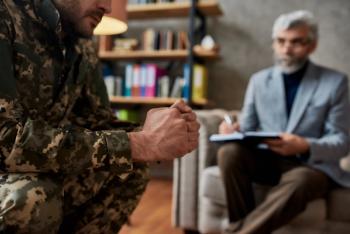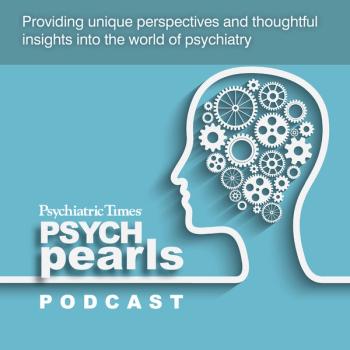
- Psychiatric Times Vol 28 No 7
- Volume 28
- Issue 7
Addressing Postdeployment Needs
Although we would all like to believe otherwise, war is not over when a service member returns home. For many, returning home may be where the harder battles begin. Intensive training prepares troops for warfare, but what training do they have to readjust when they return home?
Although we would all like to believe otherwise, war is not over when a service member returns home. For many, returning home may be where the harder battles begin. Intensive training prepares troops for warfare, but what training do they have to readjust when they return home?
The Case Vignette illustrates some of the problems that postdeployment service members face.
CASE VIGNETTE
Vince, a 32-year-old National Guard member, returned from deployment in Afghanistan 8 weeks ago. While deployed, he drove convoys between base camps, was involved in 2 heavy firefights, and was present during detonation of more than 7 improvised explosive devices. During his previous deployment, he had started to smoke again (after quitting 5 years ago when he got married). He is constantly jumpy, and he is having trouble sleeping and is having nightmares. He is also having trouble reconnecting with his family (wife and 2 sons, aged 2 and 4 years). The company he worked for full-time before he was deployed closed 1 month before his return. He cannot sleep, but he needs to focus to search for a job. He is requesting medication to help him sleep.
What to expect following deployment to war
Deployment to war is life-changing for all involved: families are separated; troops experience intense firefights, shattering blasts, death, and destruction. Those who are left at home must face challenges on their own, moving forward with daily life and taking on new responsibilities while worrying about their loved ones. At the other end of the deployment (if all goes well), families are reunited. Although safe homecomings are celebrated, the story does not end there. Reintegration challenges the soldiers and contractors who were deployed as well as their family members and loved ones who waited at home.1
The experiences of war change both troops and family members in ways civilians may never fully understand. Many positive changes occur. Service members take on grave responsibilities, learn and develop new skills and strengths, and become highly dependable. Family members often learn that they themselves are capable of more than they expected. Experiences in the military and during deployment make those who served more responsible, better leaders, and better team players.
At the same time, following deployment almost everyone will experience normal reintegration issues. To function maximally in war, troops develop battle mind-sets that must be reset to match the home context.2 Those who managed life alone at home may feel their warrior lacks an appreciation of how hard that was. All members of the family face challenges readjusting back to regular civilian life together.
Everyone must deal with the normal psychological responses to trauma that are to be expected after someone faces the traumas of war. These responses may include emotional (numbing, guilt, helpless-ness, anger, grief), cognitive (difficulty in concentrating, memory loss, self-blame, unwanted memories), physical (tension, insomnia, startle reaction, racing heart beat), and interpersonal (distrust, irritability, withdrawal, feeling rejected, being over controlling) reactions.3 Given a little time, most will readjust, but mental health disorders develop in a significant minority.
The needs of returning troops and families
The most common mental health problems seen in returning service members are posttraumatic stress disorder (PTSD), substance use disorders, and depression.4 Other medical conditions prevalent in this cohort include pain, traumatic brain injury (TBI), and sleep problems.
Even in the absence of a diagnosable condition, common reactions often experienced following trauma, in and of themselves, can lead to behavioral problems. Erratic driving, problems reestablishing previous levels of work performance and commitment, family conflict, mental health issues, broken marriages, job loss, trouble with the law, poor grades or dropping out of school, foolish spending, and risky behaviors are just some of the things that can result. Reactions can lead to feelings of disconnect, sleeping difficulties, and more. Many service members and families struggle with financial, relationship, and career issues. Mental health symptoms or problems that are present can be exacerbated by these life stressors.
Because of the complexities involved, the needs of returning troops extend far beyond obtaining treatment for mental health disorders.
Normal reintegration takes time. All troops and families need to know what is normal to expect. Normal reactions include nightmares, emotional distancing, and other symptoms (as exhibited in the Case Vignette). When symptoms are intense, disruptive, and persistent, however, PTSD should be considered. This is especially true when troubling symptoms remain or increase over a few months after demobilization, or if they continue to cause significant problems in daily life. Problems such as difficulty in functioning at work, school, or home, or significant distress, indicate that professional treatment is needed. Keeping in mind the overlap between expected readjustment problems and frank PTSD, clinicians should observe a high threshold before diagnosing PTSD in this cohort.
Following deployment, almost everyone will experience normal reintegration issues. . . . troops develop battle mind-sets that must be reset to match the home context.
Overcoming stigma. A reason to exercise caution and not overpathologize is that stigma surrounding mental health issues prevails in the military cohort. Many troops worry that mental health diagnoses and help seeking will harm their career.5 Some research suggests stigma is related to negative beliefs about mental health care, although other findings indicate that the vast majority of military members agree that mental illness can be successfully treated.6,7 Nonetheless, stigma needs to be taken into consideration.8
Importance of social support. Study findings indicate that social support is protective against the development of PTSD.9,10 As a society, the United States learned a hard lesson from our response to returning troops from Vietnam, and now there is strong support for our troops as they deploy to places such as Iraq and Afghanistan and for these troops and their families when the troops come home. But more can always be done. It is important to remember that we are a country dealing with war and its aftereffects.
Help with multiple stressors. Because of the broad range of stressors involved in reintegration, it is vital that different agencies work together, referrals are made, and an entire safety net is provided to ensure smooth reentry. The US Department of Veterans Affairs (VA), the US Department of Defense (DoD), and other federal and state agencies have been working together over the past several years to ensure this occurs. As outlined in the Case Vignette, in addition to needing help with sleep difficulties, assistance may be needed to find a new job, figure out how to reconnect with family, or quit smoking. Treatment of PTSD or related symptoms also calls for collaborative approaches.
Treatment of posttraumatic symptoms
Effective evidence-based psychotherapeutic and pharmacological treatments are available. A recently published “guide to guidelines” summarized and compared these PTSD treatments and guidelines, including the most recently revised clinical practice guideline for PTSD, a collaborative effort by the VA and DoD.11,12
Psychotherapeutic interventions. Cognitive-behavioral therapy (CBT) has been designated the treatment of choice in all PTSD practice guidelines published to date. CBT techniques address the conditioned fear and cognitive distortions associated with PTSD. Exposure and cognitive restructuring are thought to be the most effective components.13 Prolonged exposure promotes extinction of the conditioned fear that is presumed to have caused PTSD in the first place. Patients are repetitively exposed to difficult traumatic memories through imaginal (when the patient is instructed to recall an experience) or in vivo (when the patient is directly exposed to a reminder or an experience) experiences, which leads to progressive reduction in distress levels, thereby achieving clinical remission.
Cognitive processing therapy focuses on the trauma-related automatic thoughts associated with PTSD. Typical erroneous cognitions include perceiving the world as dangerous, seeing oneself as powerless or inadequate, or feeling guilty for outcomes that could not have been prevented. Through cognitive restruc-turing, the therapist challenges such distorted beliefs, thereby enabling patients to overcome intolerable trauma-related emotions such as guilt and shame.
Evidence-based practice guidelines indicate that another effective treatment is eye movement desensitization and reprocessing (EMDR). In EMDR, patients are instructed to imagine a painful traumatic memory and associated negative cognitions (such as guilt or shame) while visually focusing on the rapid movement of the clinician’s finger. Many studies have shown that such eye movements are not needed for EMDR to work, so a satisfactory rationale for its mechanism of action remains to be determined.
Medications and PTSD. Although pharmacotherapy can produce complete remission of PTSD symptoms, in general, it has not proved to be as effective as CBT. SSRIs have emerged as the treatment of choice; sertraline and paroxetine are FDA-approved for PTSD treatment. SSRIs have a broad spectrum of action that ameliorates all 3 symptom clusters of PTSD. Randomized clinical trials have also found venlafaxine, fluoxetine, mirtazapine, tricyclic antidepressants, and monoamine oxidase inhibitors to be efficacious.
The α1-adrenergic antagonist prazosin has been consistently effective in treating traumatic nightmares and its efficacy in PTSD is currently being tested. For SSRI partial responders or nonresponders, augmentation with atypical antipsychotic agents has also had positive results. Given the complex psychobiology of PTSD, it is likely that other medications, such as antiadrenergic agents, anticonvulsants, and a variety of agents currently under investigation, may eventually prove to be more effective than SSRIs.
Finally, it is important to emphasize that all practice guidelines recommend against the use of benzodiazepines for PTSD. This is because of negative results from randomized trials and the addictive nature of these medications, especially for susceptible persons. Furthermore, there is emerging evidence that benzodiazepines may interfere with exposure therapy.14
Comorbidities
The complexity of the clinical picture is a major challenge in providing treatment for active duty military and veteran patients. Co-occurring problems-including PTSD, depression, substance use disorder, postconcussive symptoms from a TBI, insomnia, pain, and aggressive behavior-are the rule, not the exception. Because there is very little research on treatment of PTSD and 1 (or more) of these concurrent problems, the consensus is to follow current clinical practice guidelines. Thus, a person with PTSD and depression should be offered evidence-based treatments for both disorders.
In many cases, this is not a problem, although there are circumstances in which lack of empirical evidence raises questions about how best to proceed. For example, when PTSD and the sequelae of mild TBI are both present, it is unknown how stimulant medications (eg, methylphenidate) routinely used for TBI will affect PTSD symptoms. Clinical trials are currently in progress to address such questions. In the meantime, the VA has issued an expert consensus document on treatment of co-occurring PTSD, TBI, and pain.15
Serving a broad array of needs
Psychiatrists who do not provide CBT themselves should ensure that they have access to psychotherapists who provide evidence-based treatments for PTSD (such as exposure or cognitive processing therapy). Because the aftereffects of war involve potentially complex and interwoven conditions, integrated services and interagency approaches are warranted. We have only provided a glimpse of the complex nature of the reintegration process. Services ranging from physical or vocational rehabilitation, financial assistance, social support, relationship assistance, or spiritual counsel may be needed.
In the past several years, collaborative and interagency approaches have been initiated to simplify access to services. The National Resource Directory (NRD), a comprehensive online resource, was developed jointly by the DoD, VA, and Department of Labor (DoL).16 This registry, which contains more than 10,000 pertinent resources, was a product of the Federal Partners Workgroup, an interagency effort of several federal agencies and associations to assist with reintegration of our returning service members.
The NRD is just one result of VA and DoD collaboration and joint initiatives with other government agencies, such as the Substance Abuse and Mental Health Services Administration and the DoL. In addition to that multifaceted resource, the
References:
References
1. Slone LB, Friedman MJ. After the War Zone: A Practical Guide for Returning Troops and Their Families. New York: Da Capo Press; 2008.
2. Battlemind/Resilience Training.
3. Friedman MJ. Post-Traumatic and Acute Stress Disorders: The Latest Assessment and Treatment Strategies. 4th ed. Kansas City, MO: Compact Clinicals; 2006.
4. VA Office of Public Health and Environmental Hazards. Analysis of VA Health Care Utilization among Operation Enduring Freedom (OEF) and Operation Iraqi Freedom (OIF) Veterans; 2010. http://www.scribd.com/doc/30640247/Analysis-of-VA-Health-Care-Utilization-among-Operation-Enduring-Freedom-OEF-and-Operation-Iraqi-Freedom-OIF-Veterans. Accessed May 27, 2011.
5. Hoge CW, Castro CA, Messer SC, et al. Combat duty in Iraq and Afghanistan, mental health problems, and barriers to care. N Engl J Med. 2004;351:13-22.
6. Pietrzak RH, Johnson DC, Goldstein MB, et al. Perceived stigma and barriers to mental health care utilization among OEF-OIF veterans, Psychiatr Serv. 2009;60:1118-1122.
7. American Psychiatric Association. Healthy Minds. Healthy Lives. Military: Family Mental Health Survey; 2008.
8. Stecker T, Fortney JC, Hamilton F, Ajzen I. An assessment of beliefs about mental health care among veterans who served in Iraq. Psychiatr Serv. 2007;58:1358-1361.
9. Brewin CR, Andrews B, Valentine JD. Meta-analysis of risk factors for posttraumatic stress disorder in trauma-exposed adults. J Consult Clin Psychol. 2000;68:748-766.
10. Kaniasty K, Norris FH. Longitudinal linkages between perceived social support and posttraumatic stress symptoms: sequential roles of social causation and social selection. J Trauma Stress. 2008;21:274-281.
11. Forbes D, Creamer M, Bisson JI, et al. A guide to guidelines for the treatment of PTSD and related conditions. J Trauma Stress. 2010;23:537-552.
12. US Department of Veterans Affairs. Management of Traumatic Stress Disorder and Acute Stress Reaction.
13. Hamblen JL, Schnurr PP, Rosenberg A, Eftekhari A. A guide to the literature on psychotherapy for PTSD. Psychiatric Ann. 2009;39:348-354.
14. Rothbaum BO, Gerardi M, Bradley B, Friedman MJ. Evidence based treatment for PTSD. In: Ruzek JI, Schnurr PP, Vasterling JJ, Friedman MJ, eds. Caring for Veterans With Deployment-Related Stress Disorders: Iraq, Afghanistan and Beyond. Washington, DC: American Psychological Association; 2011:215-239.
15. Summerall EL. Traumatic Brain Injury and PTSD. US Department of Veterans Affairs.
16. National Resource Directory. Connecting Wounded Warriors, Service Members, Veterans and Their Families With Those Who Support Them.
Articles in this issue
over 14 years ago
Resources for Veteransover 14 years ago
Returning Veterans With Addictionsover 14 years ago
Suicide Among Service Membersover 14 years ago
The Long War Comes Homeover 14 years ago
Introduction: Serving Those Who Serveover 14 years ago
Deep Water Testover 14 years ago
A Response by Daniel Carlatover 14 years ago
REMS Program for Opioid AnalgesicsNewsletter
Receive trusted psychiatric news, expert analysis, and clinical insights — subscribe today to support your practice and your patients.

















